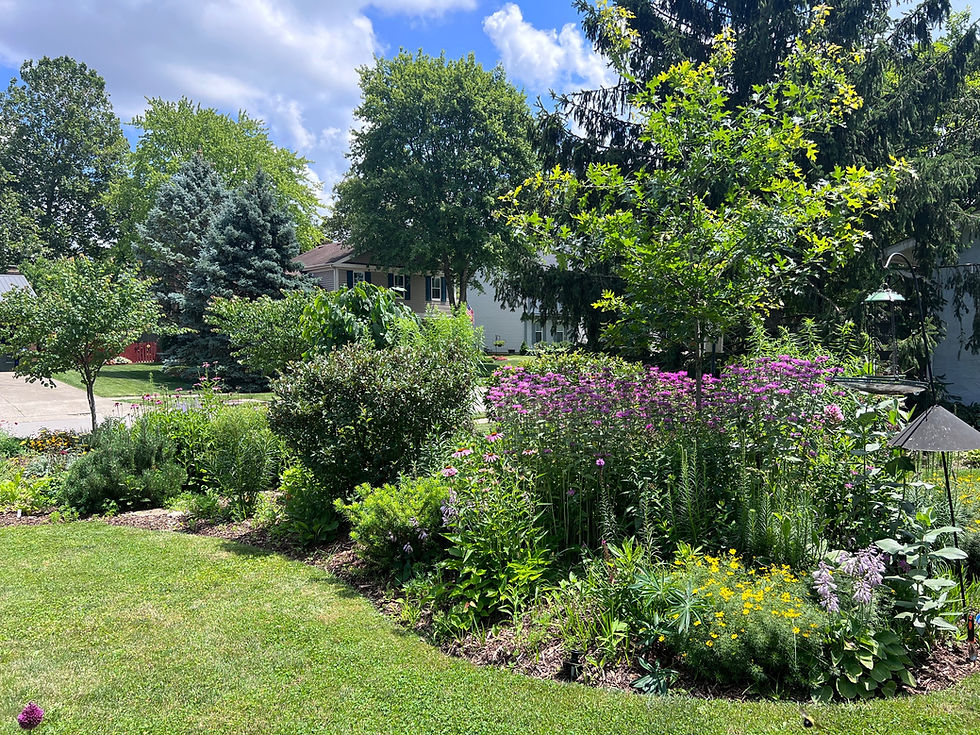How to Reduce the Size of Your Lawn
- Cathy Tiffany

- Feb 26, 2024
- 3 min read
AKA: Why do you have so much grass?
There's been a big movement lately to reduce the size of your suburban lawn and replace it with something better. Why?
A sprawling lawn really serves no purpose. If you have little kids that love to play outside, I'd be the first to concede that some lawn would be helpful, but the vast majority of suburban yards don't need as much grass as they have. While playing flag football, tag and keep-away in the yard is fun, the kids that come to our house have far more fun investigating the ponds, checking out the chickens, chasing butterflies and eating raspberries.
The real issue with having so much grass is that it leaves no room for nature. Consider this statistic from Business Insider:
Turf grasses occupy 2% of the land in the continental US. That's more acreage than the amount of land used to grow irrigated corn. Americans use huge amounts of water to grow grass, harm the environment fertilizing it, and spend about $30 billion on lawn care every year.

And what's crazier? Most of the people who douse their lawns with chemicals don't even have fun in their lawn! They kinda just look at it. Another crazy thing: we rake up all the leaves and bag them up. If we mulched the leaves up and left them on the lawn (finely mowed up or mulched up), the leaves would decay and naturally fertilize the lawn, no money or chemicals needed. We don't treat our lawn and mulch up the leaves (most of the time) and have a nice, green lawn (what's left of it).
Approximately 40 million U.S. acres are planted as lawn, including residential and commercial properties and golf courses. More land in the U.S. is devoted to lawns than irrigated crops like corn or wheat.
30-60% of urban fresh water is used for watering lawns, depending on the city.
67 million pounds of synthetic pesticides are used on U.S. lawns annually.
Yard waste, mostly grass clippings, makes up 20% of municipal solid waste collected, and much of it ends up in landfills.
Lawns have less than 10% of the water absorbing capacity of natural woodlands, which contributes to suburban flooding.

Just on the pesticide front, most folks don't make the connection that by spraying pesticides on their lawns, this is the very reason they don't see fireflies, lightning bugs, ladybugs and all the other cutie insects anymore. They were killed by the pesticides. Pesticides kill virtually everything, not just the insects you don't like.
Unlike many native plants, turf grasses do not provide a good source of food or habitat for most types of wildlife.
When migratory monarch butterflies are on the move, they rely on sources of nectar on their journey north and south. If there's nothing but grass, there's nothing to eat...and they die. Replacing some lawn with some native habitat areas not only cuts down your mowing time, but it also gives a space for nature.
So, what to do?
Consider small steps if you aren't ready for big changes.
Click HERE for a downloadable PDF on Lawn Reduction from the National Wildlife Federation.
I like to recommend that if you have a small flower bed around your porch or sidewalk, maybe widen it by 6-12" more, which will be less lawn and more beneficial plants.
Consider taking a corner of your yard and adding a native bush, some native flowers and a birdbath to make a little "habitat".
These are just a couple of ideas on how to reduce your lawn size, save money and enjoy your yard more. When you click the link above for the PDF, you'll find more ideas and hopefully be inspired to commit to adding more nature to your home.











Comments